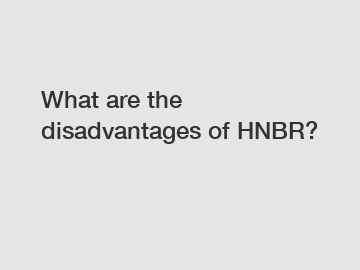What are the disadvantages of HNBR?
What are the disadvantages of HNBR?
HNBR, also known as Hydrogenated Nitrile Butadiene Rubber, is a synthetic rubber compound that offers excellent resistance to heat, chemicals, and oil. However, despite its numerous advantages, HNBR has a few disadvantages that need to be considered in certain applications.
One of the main disadvantages of HNBR is its relatively high cost compared to other rubber materials. The manufacturing process for HNBR involves additional steps, such as hydrogenation, which increases the production cost. This can limit its use in applications where cost-effectiveness is a primary concern, especially when alternative materials can provide sufficient performance at a lower price.

Another drawback of HNBR is its limited low-temperature flexibility. While HNBR exhibits good high-temperature resistance, it becomes stiff and less flexible at low temperatures. This can be a crucial factor in applications that require rubber materials to maintain their properties in cold environments. Failure to consider this drawback can lead to potential operational issues and compromised performance.
Furthermore, HNBR has lower resistance to ozone compared to some other elastomers. Ozone, a highly reactive gas, can cause degradation and cracking of rubber materials over time. Although HNBR generally performs well in many challenging environments, its susceptibility to ozone can limit its usage in certain applications where exposure to ozone is significant. Proper protection or the use of alternative materials with better ozone resistance should be considered in such cases.
Despite these disadvantages, HNBR still offers significant advantages in many applications. Its excellent resistance to heat, chemicals, and oil make it suitable for use in seals, gaskets, and O-rings in demanding industries, including automotive and oil and gas. HNBR's ability to withstand high temperatures and its resistance to fluids and chemicals contribute to its extended service life and reliable performance in harsh environments.
To mitigate the limitations of HNBR, manufacturers have developed modified grades of HNBR that exhibit enhanced low-temperature flexibility and improved ozone resistance. These modified grades, while more expensive than standard HNBR, offer better performance in extreme conditions, expanding the range of applications where HNBR can be effectively used.
In conclusion, while HNBR has certain disadvantages such as its high cost, limited low-temperature flexibility, and lower resistance to ozone, these drawbacks can be overcome or mitigated by considering alternative materials or utilizing modified HNBR grades. Understanding the limitations of HNBR is crucial for selecting the most suitable material for specific applications, ensuring optimal performance and cost-effectiveness.
For more Abrasion Resistant Rubber Sheet, Hammer Top Cow Rubber Mat China Supply, High Tensile Strength Nr Rubber Sheetinformation, please contact us. We will provide professional answers.
259
0
0

Comments
All Comments (0)